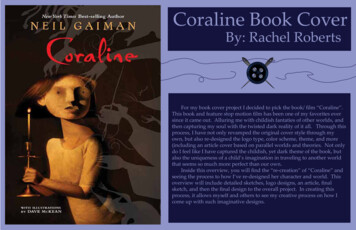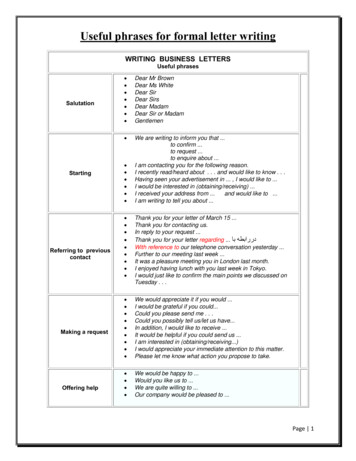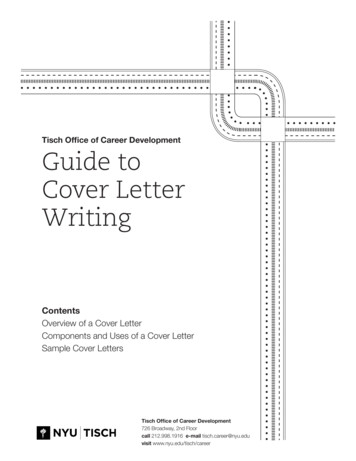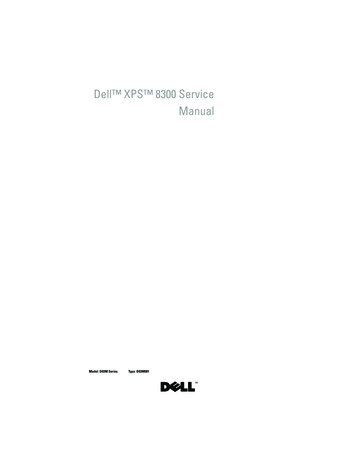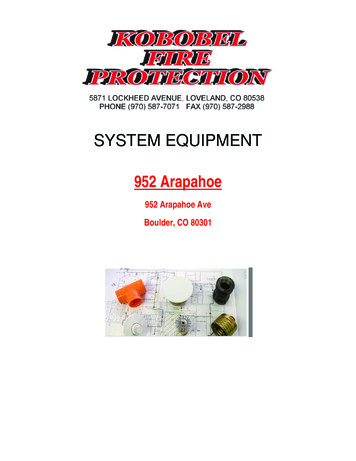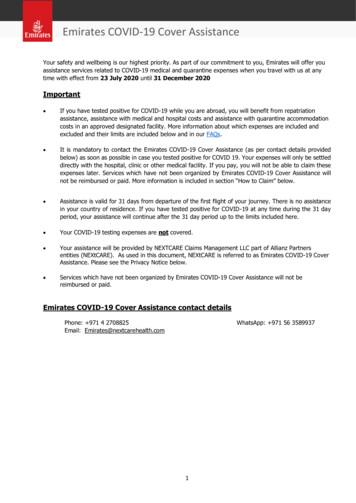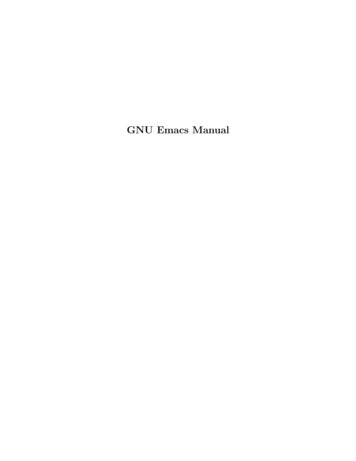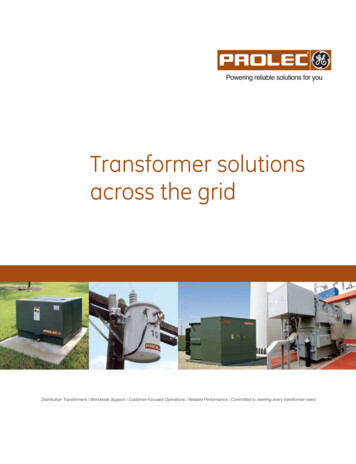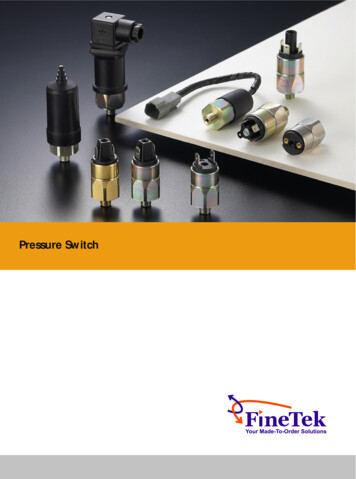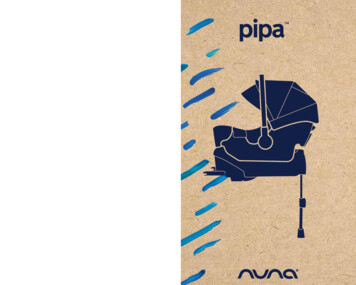
Transcription
IM-0246D
Designedaround your life
ContentsIMPORTANT!KEEP THESEINSTRUCTIONS FORFUTURE REFERENCE:READ CAREFULLY2PIPA instructionsProduct InformationProduct RegistrationRecall InformationWarrantyContact4455Child Usage Requirements5Warnings6Car Seat Use after a Crash10Vehicle Compatibility11Infant Car Seat Parts List14Base Parts List16Product Overview18Product Use28Installation32Cleaning and Maintenance49PIPA instructions3
Product InformationModel Number:Manufactured in (date):Product RegistrationPlease fill in the above information. The modelnumber and the manufactured in date are locatedon a label on the bottom of your child restraint. Fillout the prepaid registration postcard attached tothe seat pad and mail it today.Child restraints could be recalled for safetyreasons. You must register this restraint to bereached in a recall. Send your name, address,e-mail address if available and the Child Restraint’smodel number and manufacturing date to:Nuna Baby Essentials Inc.70 Thousand Oaks Blvd.Morgantown, PA 19543or call 1.855.NUNA.USAor register online at:www.nunababy.comClick on the “Register Car Seat” link on thehomepage.Recall InformationFor recall information, call the U.S. Government’sVehicle Safety Hotline at: 1.888.327.4236(TTY: 1.800.424.9153) or go tohttp://www.NHTSA.gov4PIPA instructionsWarrantyWe have purposely designed our high-qualityproducts so that they can grow with both your childand your family. Because we stand by our product,our gear is covered by a custom warranty perproduct, starting from the day it was purchased.Please have the proof of purchase, model numberand manufactured in date available when youcontact us.For warranty information please visit:www.nunababy.com/warrantyContactFor replacement parts, service, or additionalwarranty questions, please contact our customerservice department.In the .USAChild Usage RequirementsThis child restraint is suitable for use with childrenwho meet the following requirements:Weight: 4 to 32 lb (2 to 14.5 kg)Height: less than 32 inches (81 cm)It is recommended to keep your child rear facing aslong as possible, until at least 2 years old.PIPA instructions5
WARNINGFailure to follow these warnings,instructions and labels on the childrestraint could result in serious injury ordeath.A child’s safety is your responsibility.NEVER leave your child unattended.Read all instructions before use of thischild restraint or installation in a vehicle.In addition, read the vehicle owner’smanual for information on child restraintinstallation.Use the bottom of the base for storage ofthe instruction manual.Register your child restraint with themanufacturer.This child restraint can ONLY be usedin a rear facing position when using ina vehicle. The child restraint cannot beproperly secured in a forward facingposition, and will be unsafe. Use only withchildren who weigh between 4 and 32pounds (2 and 14.5 kg) and whose heightis 32 inches (81 cm) or less. Exceedingthese height and weight limits is unsafe.6PIPA instructionsCover the child restraint when your vehicleis parked in sunlight. Parts of a childrestraint can become very hot if left in thesun, and can burn a child’s skin. Check forhot parts before putting your child in thechild restraint.Secure this child restraint with thevehicle’s child restraint anchorage systemif available, or with a vehicle belt.Replace this child restraint if it has beeninvolved in a crash, even if it was minorand there appears to be no damage to thechild restraint.Snugly adjust the belts provided withthis child restraint around your child. Ifstraps are not snugly adjusted, child maybe ejected from seat in the event of anaccident.A snug strap should not allow any slack.It lies in a relatively straight line withoutsagging. It does not press on the child’sflesh or push the child’s body into anunnatural position.EXPIRATION DATE Check the label on theunderside of the base or child restraint forexpiration date information.PIPA instructions7
FALL HAZARD Child’s activity can movecarrier. NEVER place carrier on countertops, tables, or any other elevated surface.Always stay within arm’s reach whenevercarrier is not on floor/ground. Be surehandle locks intoposition before liftingcarrier.The carrier can fallfrom a shopping cart.DO NOT USE on ashopping cart.STRANGULATIONHAZARD Childrenhave strangled in loose or partially buckledharness straps. Fully restrain the child evenwhen carrier is used outside the vehicle.SUFFOCATION HAZARD Infant carrier canroll over on soft surfaces and suffocatechild. Never place carrier on beds, sofas,or other soft surfaces.ALWAYS check child restraint to baseconnection.DO NOT allow anyone who has not readthe instruction manual to install or use thischild restraint.8PIPA instructionsDO NOT allow child restraint or handle tocontact the vehicle interior (side of car dooror seat in front) when installed on base.DO NOT use child restraint if it has frayedor cut harness straps, or is damaged inany way. To find out if damaged parts arereplaceable, call 1-855-NUNA-USA.DO NOT use any products or accessorieswith this child restraint unless they areapproved by Nuna for use with this childrestraint. Doing so may be unsafe and mayvoid the warranty.DO NOT leave child restraint and basein vehicle when uninstalled, even whenunoccupied. In a crash, it could become aprojectile and injure other vehicle occupants.NEVER modify any part of the child restraint.NEVER use clothing or blankets thatinterfere with providing a properlytightened harness. An unsecured orimproperly harnessed child can comeout of the restraint during a crash. Placeblankets over child AFTER harness hasbeen properly tightened.Only use with Nuna strollers orappropriate Nuna adapters designed foruse with other strollers.PIPA instructions9
Car Seat Use after a CrashThe National Highway Traffic Safety Administration(NHTSA) recommends that car seats be replacedfollowing a moderate or severe crash. Car seats donot automatically need to be replaced following aminor crash.What defines a minor crash?A minor crash is one in which ALL of the followingapply: The vehicle was able to be driven away fromthe crash site. The vehicle door nearest the car seat was notdamaged. None of the passengers in the vehiclesustained any injuries in the crash. If the vehicle has air bags, none of the air bagsdeployed during the crash; and There is no visible damage to the car seat.NEVER use a car seat that has been involved ina moderate to severe crash. Contact Nuna withquestions or concerns about your seat.Information from nhtsa.govVehicle CompatibilityYou MUST read and understand ALL child restraintrelated instructions and warnings in your vehicleowner’s manual to correctly and safely use thischild restraint in your vehicle.This child restraint can ONLY be installed onvehicle seats that face forward. DO NOT install inseats that face to the sides or rear of the vehicle.NEVER install this child restraint rear facing in avehicle seating position with a frontal air bag unlessit is turned off. Airbags inflate with great force andcan cause severe injury to a child’s neck and spine.If your vehicle is equipped with passenger side airbags, check your vehicle owner’s manual for childrestraint installation instructions.According to accident statistics, children aresafer when properly restrained in the rear seatingpositions than in the front seating positions.Refer to your vehicle owner’s manual to determineif the belts in your vehicle lock by switching theseat belt’s retractor OR if they have a locking latchplate that locks the vehicle’s seat belt so they willhold the child restraint tightly without loosening.10PIPA instructionsPIPA instructions11
142536Vehicle belts that CANNOT BE USED with yourchild restraint:1 - Motorized Belts (Automatic)These should not be used unless the shoulderbelt can be removed, the lap belt is locked anduse is allowed by the vehicle manufacturer.2 - Dual Retractor Lap/Shoulder BeltsIf allowed by the manufacturer, the lap beltonly may be used to secure the child restraintin accordance with this manual and the vehicleowner’s manual.3 - Non-Locking (ELR) Lap BeltsThis belt locks in a crash or sudden stop andshould only be used with a belt shortening clip.Contact your vehicle manufacturer if needed.4 - Airbag/Inflatable BeltsThis belt cannot be used to install this childrestraint.5 - Door Mounted BeltsThis belt cannot be used to install this childrestraint.6 - Lap Belts forward of Seat BightThis belt (Where the seat bottom and seat backmeet) should not be used to install this ChildRestraint.12PIPA instructionsPIPA instructions13
Infant Car Seat Parts List1234CanopyInfant InsertChest ClipBuckle and CrotchBelt5 Adjuster Button6 Adjuster Strap7 Lap Belt Guides8 Handle Button9 Stroller ReleaseButton10 Shoulder Pads111213141516171819Seat CoverHandleShoulder Belt GuideStroller ReleaseHandle*Harness SlotsBase AttachmentBarHarness StrapsSplitter PlateBase AttachmentBar12123114105986714131516171819*only used with infant car seat adapters14PIPA instructionsPIPA instructions15
Base Parts List1234567Lock OffRigid LATCH(lower attachments)Primary RigidLATCH ReleaseButtonSecondary RigidLATCH ReleaseButtonRigid LATCH GuidesLocking ClipStability Leg891011121314Stability LegIndicatorStability Leg AdjustButtonCar Seat ReleaseButtonBubble IndicatorInstruction ManualStorageStability LegStorageRecline Adjustment111102345976812131416PIPA instructionsPIPA instructions17
Product Overview1425Dream Drape 1 - Unzip the zipper behind the front canopy bow.2 - Pull the Dream drape out of the compartmentand attach the Dream drape to the magnetson each corner to the front of the carrier.Canopy3 - To remove the canopy, undo the snap on thecanopy fabric. Press the button in the canopymount and pull the canopy bow out.frontShoulder Pads4 - Shoulder pads are removable and are notbacknecessary for safety.Infant Insert5 - The infant insert can be used as necessary,to provide a snug fit for small babies. The lowbirth weight pillow (highlighted) can be usedin the infant insert for even smaller babies,but should be removed once a snug fit can beachieved without it, at approximately 11 lb.18PIPA instructions3PIPA instructions19
Handle Adjustment1 - The carrier handle can be adjusted to 312positions.2 - To adjust the handle position, squeeze handlebuttons on both sides.3 - Rotate handle until it clicks into any of the 3positions. Handle can be used in vehicle in anylocked position.Be sure handle is locked in the carry positionbefore lifting child restraint by handle. Anunlocked handle could move unexpectedly,causing injury to child.3Handle MUST NOT contact the vehicle interior(side of car or seat in front) when installed.20 PIPA instructionsPIPA instructions21
Seat Pad1 - Pull out the fastening pieces underneath the1324edge of the seat.The best way to work this area (as some seatpads feel more tight in this area than others)is to pull the fabric towards the front of the seatat one corner. Once you have one corner out,you can easily work the other side out.2 - Remove the harness from the splitter plate.3 - Remove the seat pad from the stroller releasebuttons* as shown.*Feature used only with infant car seat adapters. Infant carseat adapters for strollers sold separately.4 - Grasp the seat pad at the bottom of theadjuster button as shown and pull the seatpad out from under one edge of the adjusterbutton. Work around the adjuster button torelease the remainder of the seat pad.22 PIPA instructionsPIPA instructions 23
Shoulder Belts1 - Tighten harness to fit snugly on child’s1425shoulders. It is snug if you cannot pinch a foldin the strap.2 - Harness straps must be at or just belowshoulders.3 - To adjust shoulder harness height, removechild and loosen harness.4 - Turn child restraint over and remove oneharness loop from metal splitter plate.5 - Pull loose ends of harness out through slotsand place in correct slot.324 PIPA instructionsPIPA instructions 25
1 - Re-attach harness loops to splitter plate.2Do not allow harness to pass over bars.142536Repeat process for second shoulder harness strap.Crotch Belt3 - Identify crotch belt slot that will achieve a snugfit for your child. Three crotch belt positionsare provided to achieve a snug fit as your babygrows. Change crotch belt slot as necessary.4 - The position shown provides the smallest fit.Crotch belt is threaded through rear slot andup through front slot as shown.5 - This position provides a medium fit. Crotch beltis threaded into rear slot as shown.6 - This position provides the largest fit. Crotchbelt is threaded through front slot as shown.26 PIPA instructionsPIPA instructions27
Product Use141 - Top of child’s head is at least 1” below top ofchild restraint.Securing Child in Child Restraint2 - Loosen harness by pressing on adjuster button1 in(25 mm)while pulling on the harness straps.3 - Press button to release the buckles. Separatechest clip and spread harness straps apart.4 - Place child in child restraint in seated position.5 - The child should be seated against both the2536back and bottom of the seat with no gapbehind the child. Do not allow child to slouch.Gently guide child’s arms through harness loops.6 - Insert buckle tongues into buckle.228 PIPA instructions12PIPA instructions 29
1 - Listen for clicks. Pull on buckle to verify it islatched.132 - Snap the chest clip together and temporarilyslide towards buckle for tightening of harness.3 - Tighten harness by pulling on the adjusterstrap. Pull any excess harness webbing throughthe buckle towards the child’s shoulders andpull on the adjuster strap. This may need to berepeated several times for proper fit.Verify that the harness is snug around thechild’s waist and shoulders.4 - Position the chest clip at child’s armpit level.Check that Child is SecureBuckle is fastened.Harness straps are not twisted.Harness is snug – A snug harness cannot bepinched, and should not allow any slack.Chest clip is level with armpits.click24clickHarness straps must be at or just below child’sshoulders to avoid injury. If harness slots needto be moved, see Shoulder Belts section.Make sure that nothing interferes with theharness. Make sure harness is snug aroundchild and lays flat. Serious injury or death couldoccur to a child that is not secured properly.If child is not secured properly, child couldbe ejected in a sudden stop or crash, resultingin serious injury or death.30 PIPA instructionsPIPA instructions31
Installation142536If child is not secured properly, child couldbe ejected in a sudden stop or crash, resultingin serious injury or death.Base Installation Using Rigid LATCH(Lower Attachments)1 - Place vehicle in park and on level ground.2 - Position base in a forward facing vehicle seat.Use recline adjustment to position bubble inindicator. Adjust base so bubble touches line.3 - Use recline adjustment to achieve correctangle for installation. Recline adjustment locksinto position.4 - To release press down on lock button.5 - When installing with the base, additionalstability can be achieved by using the stabilityleg. For instructions on using the stabilityleg when installing the base, see stability legsection.6 - If necessary, install rigid LATCH guides onvehicle32 PIPA instructionsLATCH lower anchor bars.PIPA instructions 33
1 - Rotate Rigid LATCH (lower attachments) down.2 - Hook Rigid LATCH onto vehicle LATCH lower14anchor bars.click3 - Confirm proper installation by pulling on thebase AND also seeing that green is indicatedon the connectors.The Rigid LATCH (lower attachments) must beattached and locked onto the vehicle anchor bars.Check InstallationBase should not move side to side or forwardmore than 1” at belt path.Bubble must be touching line. Use reclineadjustment, if needed, to position bubble.25clickIt is acceptable to install with both LATCH (lowerattachments) and the vehicle belt.click21Attaching Child Restraint to Base4 - After child is properly secured in childrestraint, press child restraint on base andlisten for a click. Pull on child restraint to verifyinstallation.3DO NOT allow child restraint to contact thevehicle interior (side of car or seat in front)when installed.5 - To release the child restraint, squeeze the carseat release button (1) located on the base,while pulling the child restraint up (2).34 PIPA instructionsPIPA instructions 35
1 - To remove the base, first push the base towardthe vehicle seat with a light force.14252 - As you push the base toward the vehicle seat,squeeze the Secondary (1) and Primary RigidLATCH Release Buttons (2).*For ease of release, push the secondary button first, then theprimary button.3 - Then pull the base off of the lower anchor bars.Installation Using Lap & Lap/Shoulder Belt4 - Place vehicle in park and on level ground.5 - Position base in a forward facing vehicle seat.Use recline adjustment to position bubble inindicator. Adjust base so bubble touches line.6 - Use recline adjustment to achieve correctangle for installation.2316236 PIPA instructionsPIPA instructions37
1 - Recline adjustment locks into position. To234-5release press down on lock button. Wheninstalling with the base, additional stabilitycan be achieved by using the stability leg. Forinstructions on using the stability leg wheninstalling the base, see Stability Leg section.Route the vehicle belt through the opening inthe base labeled ‘belt here’.Buckle the vehicle belt. Both the shoulder ANDlap belt must be under the blue lock off andbelts must lay flat.While pressing the base into the vehicle seat(1), tighten the vehicle belt by pulling straightalong the belt path (2), keeping both beltslaying flat in the lock off.While the shoulder belt is tight, hook thebottom of blue lock off and press to close thelock off on the shoulder and lap belt.If vehicle only has a lap belt, then put lap beltunder blue lock off.Check InstallationBelts must be tight.Base should not move side to side more than1” at belt path.Bubble must be touching line.Belts and buckles must not interfere withattachment of child restraint to base.Vehicle belts must lay flat under lock off.1412253clickIt is acceptable to install with both LATCH (lowerattachments) and the vehicle belt.38 PIPA instructionsPIPA instructions 39
1 - After child is properly secured in childrestraint, press child restraint on base andlisten for a click. Pull on child restraint to verifyinstallation.14clickDO NOT allow child restraint to contact thevehicle door or seat in front of it.2 - To release the child restraint, squeeze the carseat release button (1) located on the base,while pulling the child restraint up (2).3 - To remove the base, lift up on the lock off.4 - Unbuckle the vehicle belt and un-route theshoulder and lap belt from the base.2Then remove the base.52Stability LegRefer to vehicle owner’s manual to determine ifstability leg can be used over a vehicle storagecompartment.125 - Unfold the stability leg from storagecompartment.6 - Do not use if stability leg lifts base off seat.36Do not use stability leg to recline the base.The recline adjustment feature is meant torecline the base.Always store stability leg when not in use.40 PIPA instructions2PIPA instructions41
1 - After correctly installing the base on the vehicleseat, press the stability leg adjust button toextend the stability leg to the floor.13242 - Stability leg should make firm contact with thevehicle floor.3 - Indicators should show green.When the stability leg indicator shows red thismeans the stability leg is in the wrong position.Make sure the stability leg is secure and makesfirm contact with the vehicle floor. The stabilityleg indicator shows green when it is properlycontacting the floor of the vehicle.The stability leg has 12 positions.This seat is safe to use with stability leg inuse or stored for both rigid LATCH or vehiclebelt installation.Child Restraint Only InstallThis child restraint can be installed without a basein 3 different ways.4 - Place vehicle in park and on level ground.Position child restraint so that child is facingthe rear of the vehicle.Only install in a forward facing vehicle seat.42 PIPA instructionsPIPA instructions 43
1 - Option 1: Route the vehicle lap belt under bothlap belt guides and buckle the vehicle belt.Allow shoulder belt to lay against vehicle seatback as shown.1425362 - Option 2: Route the shoulder belt around theback of the child restraint passing through theblue shoulder belt guide.3 - Option 3: If your vehicle does not have ashoulder belt, the lap belt only can be used.4 - Adjust the angle of the child restraint. A rolledup towel or foam pool noodle may be used tohelp adjust the amount of recline.5 - Angle is correct when blue line on childrestraint (located on the label on the side of thechild restraint) is level with ground.6 - Tighten vehicle belt while pushing childrestraint firmly into vehicle seat. Lock thevehicle belt. Refer to vehicle owner’s manualfor instructions. If you cannot lock the vehiclebelt, you must use the provided locking clip.Tension the vehicle belt as much as possible,checking that it is not loose or twisted.Check InstallationBlue line must be level with ground.Vehicle belt must be buckled, tight andmust stay locked.Child restraint should be stable and not moveside to side more than 1 inch at belt path.44 PIPA instructionsPIPA instructions 45
Locking Clip UseIf you determine that you need to use a locking clip,tighten the buckled belt by pushing down hard onthe infant child restraint and pulling hard on theshoulder belt.131/2 in(12.5 mm)While pushing down on child restraint, pinch thetwo straps together behind the buckle tongue.Unbuckle the vehicle belt without allowing it to slip.1 - Connect lap and shoulder belts with lockingclip.2 - Reroute vehicle belt if necessary. Check thatlap belt does not move by pulling and pushinghard on infant restraint. If belt loosens orlengthens, repeat procedure.24The locking clip should be 1/2 inch (12.5 mm)from the vehicle buckle.Installation in an AircraftPosition child restraint so that child is facing theaircraft seat back.123 - Route the aircraft lap belt under both lap beltguides and buckle.4 - Adjust the angle of the child restraint. A rolledup towel or blanket may be used to help adjustthe amount of recline (1). The angle is correctwhen the blue line is level with the floor of theaircraft (2).Tighten the aircraft belt while pushing the childrestraint firmly into the seat.46 PIPA instructionsPIPA instructions47
When installing in an airplane using a base, followthe instructions for vehicle installation with a baseusing lap belt only.This child restraint is certified for use in commercialaircraft with or without the base. Be sure to contactyour airline prior to travel to discuss their usepolicy.Installation on a StrollerThis carrier can attach to Nuna strollers usingadapters. Instructions are included with theadapters, which are sold separately.This carrier can also attach to other brands ofstrollers using adapters. Please visit nunababy.comfor more information.Cleaning and MaintenanceRefer to the care label attached to the soft goodsfor washing and drying instructions.DO NOT attempt to remove the foam under theseat pad.Use only mild detergent, water and a soft cloth toclean the infant carrier shell, handle and harnessstraps. Air dry.To clean the buckle: rinse using warm water. DONOT use any soaps, solvents or lubricants. Usinganything other than water can cause the buckle tomalfunction. Air dry.Remove the child restraint from the vehicle seat ifnot in use for a long period of time. Put the infantcarrier in a cool, dry place and somewhere yourchild cannot access it.It is normal for fabric to color from sunlight and toshow wear and tear after a long period of use, evenwhen used normally.Check regularly if everything functions properly.If any parts are torn, broken, or missing, stop usingthis product.Nuna Baby Essentials, Inc. Nuna and all associated logos are trademarks.48 PIPA instructionsPIPA instructions 49
Nuna Baby Essentials Inc. 70 Thousand Oaks Blvd. Morgantown, PA 19543 or call 1.855.NUNA.USA or register online at: www.nunababy.com Click on the “Register Car Seat” link on the homepage. Recall Information For recall information, call the U.S. Government’s Vehicle Safety
